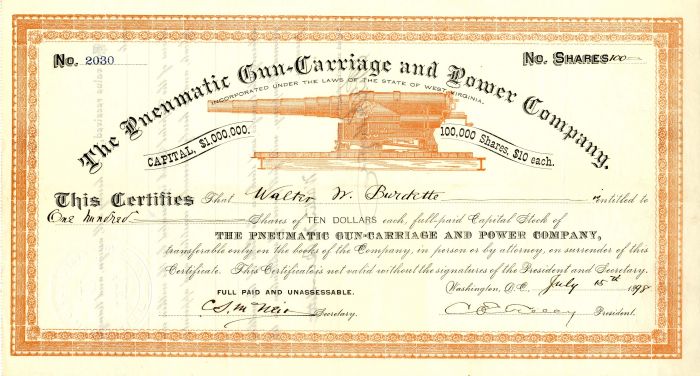Pneumatic Gun-Carriage and Power Co. - Stock Certificate with Cannon Vignette
Inv# GN1005A Stock
West Virginia
Stock printed by Gibson Brothers, Washington. Similar to item #GN1006, except gun is pointing in opposite direction. Worthy of further research. Rare color!
A pneumatic weapon is a weapon that fires a projectile by means of air pressure, similar in principle to the operation of pneumatic tube delivery systems. The term comes from a Greek word for "wind" or "breath".
In theory, pneumatic weapons have certain advantages over traditional firearms:
- The ammunition needs no propellant or casing; the entire round becomes the projectile. This makes it smaller, lighter, easier and cheaper manufactured, and safer. For the same payload, more projectile can be fired.
- Since no propellant is fired, there is no chemical residue to accumulate in the barrel or chamber, no fumes or odor either.
- Because there is no casing to eject, the firing mechanism can be simpler (resulting in a more reliable and cheaper weapon), and it is theoretically possible to have a higher rate of repeat fire.
- The gas is cool to begin with, and furthermore undergoes adiabatic cooling as it pushes the projectile, instead of being a high temperature mixture. The barrel is not heated to nearly the same extent as with a firearm, and doesn't have to withstand so high temperature.
- pressure can be controlled and adjusted, instead of being a fixed parameter of the ammunition.
On the other hand,
- The action, or the mechanism by which subsequent rounds are automatically reloaded, must also be powered by the air pressure; that is not a major drawback as pneumatic tools such as nail gun proves.
- The weapon has to supply or be supplied with a source of very high pressure gas. What is won in complexity and weight around the ammunition, is lost on the other hand in reservoir and compressor, which are not that easily provided. In most case the trade-off on this item proves to favor the firearm.
In practice, steam cannons and airguns were developed throughout 17th to 19th century, and the latter even in service with the Austrian army from 1780 to around 1815, but firearms kept the upper hand.
The low projectile speed requirement of a toy weapon greatly reduces the amount of air pressure needed; combined with the importance of safety in the toy industry, this has led to widespread adoption of pneumatic firing mechanisms in toy weapons, where a propellant reaction is not appropriate (although other technologies, such as rubber bands, can be used).
The toy industry has produced a number of pneumatic toy weapons, which fire small, lightweight (often plastic and frequently hollow) projectiles at relatively low speeds. Airsoft and paintball guns are a popular toy that operates this way; when used with adequate safety equipment (eye protection at a minimum) these may be used in games involving shooting at other players.
BB guns and other low powered air guns are often marketed towards the youth market. While a lethal wound is unlikely due to their low power, the steel and lead projectiles they fire can readily penetrate the skin. Gun safety rules should be followed when using air guns and BB guns.
A stock certificate is issued by businesses, usually companies. A stock is part of the permanent finance of a business. Normally, they are never repaid, and the investor can recover his/her money only by selling to another investor. Most stocks, or also called shares, earn dividends, at the business's discretion, depending on how well it has traded. A stockholder or shareholder is a part-owner of the business that issued the stock certificates.










Ebay ID: labarre_galleries